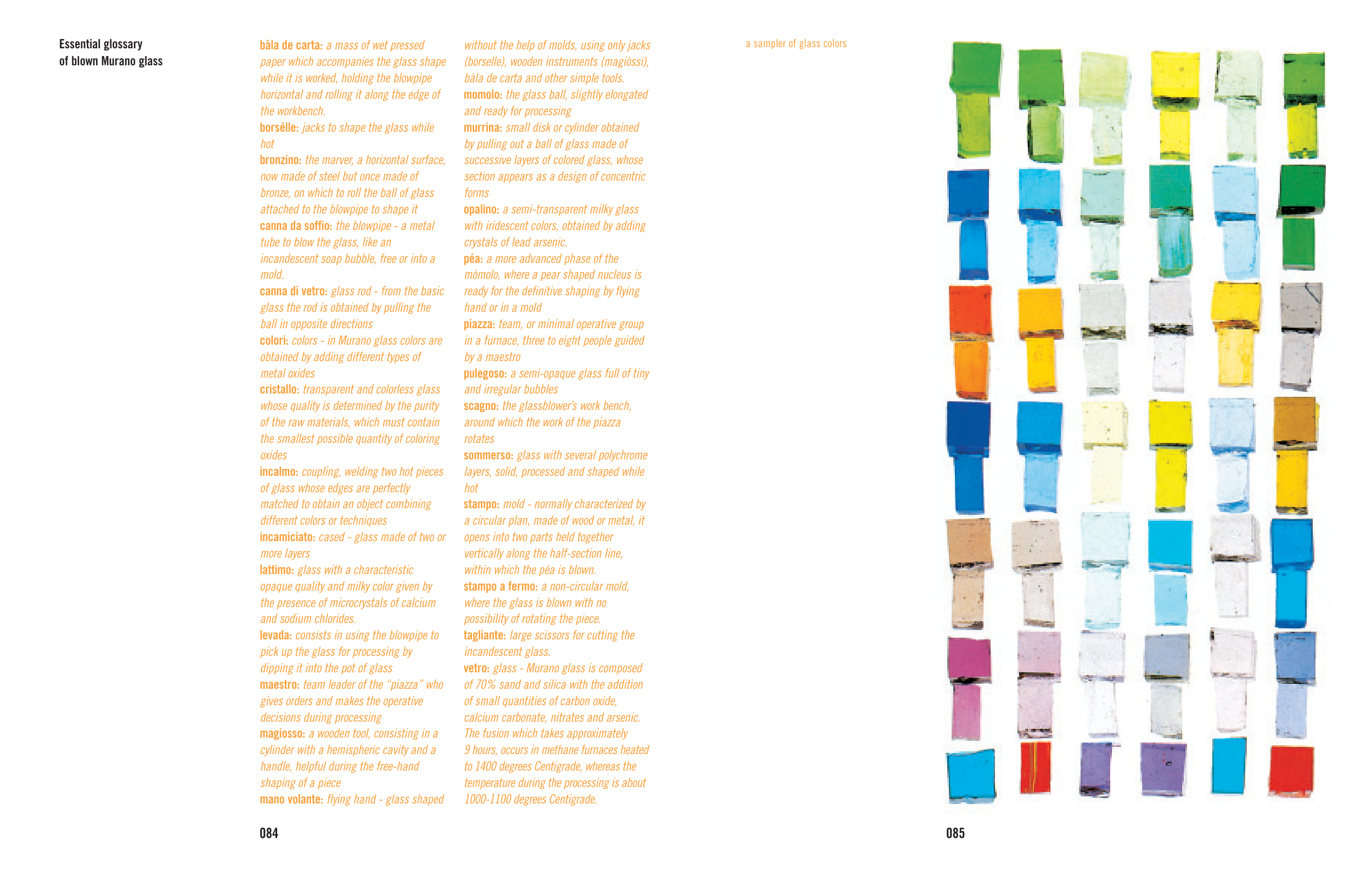a sampler of glass colors
Essential glossary
of blown Murano glass
085
084
bàla de carta: a mass of wet pressed
paper which accompanies the glass shape
while it is worked, holding the blowpipe
horizontal and rolling it along the edge of
the workbench.
borsélle: jacks to shape the glass while
hot
bronzino: the marver, a horizontal surface,
now made of steel but once made of
bronze, on which to roll the ball of glass
attached to the blowpipe to shape it
canna da soffio: the blowpipe - a metal
tube to blow the glass, like an
incandescent soap bubble, free or into a
mold.
canna di vetro: glass rod - from the basic
glass the rod is obtained by pulling the
ball in opposite directions
colori: colors - in Murano glass colors are
obtained by adding different types of
metal oxides
cristallo: transparent and colorless glass
whose quality is determined by the purity
of the raw materials, which must contain
the smallest possible quantity of coloring
oxides
incalmo: coupling, welding two hot pieces
of glass whose edges are perfectly
matched to obtain an object combining
different colors or techniques
incamiciato: cased - glass made of two or
more layers
lattimo: glass with a characteristic
opaque quality and milky color given by
the presence of microcrystals of calcium
and sodium chlorides.
levada: consists in using the blowpipe to
pick up the glass for processing by
dipping it into the pot of glass
maestro: team leader of the “piazza” who
gives orders and makes the operative
decisions during processing
magiosso: a wooden tool, consisting in a
cylinder with a hemispheric cavity and a
handle, helpful during the free-hand
shaping of a piece
mano volante: flying hand - glass shaped
without the help of molds, using only jacks
(borselle), wooden instruments (magiòssi),
bàla de carta and other simple tools.
momolo: the glass ball, slightly elongated
and ready for processing
murrina: small disk or cylinder obtained
by pulling out a ball of glass made of
successive layers of colored glass, whose
section appears as a design of concentric
forms
opalino: a semi-transparent milky glass
with iridescent colors, obtained by adding
crystals of lead arsenic.
péa: a more advanced phase of the
mòmolo, where a pear shaped nucleus is
ready for the definitive shaping by flying
hand or in a mold
piazza: team, or minimal operative group
in a furnace, three to eight people guided
by a maestro
pulegoso: a semi-opaque glass full of tiny
and irregular bubbles
scagno: the glassblower’s work bench,
around which the work of the piazza
rotates
sommerso: glass with several polychrome
layers, solid, processed and shaped while
hot
stampo: mold - normally characterized by
a circular plan, made of wood or metal, it
opens into two parts held together
vertically along the half-section line,
within which the péa is blown.
stampo a fermo: a non-circular mold,
where the glass is blown with no
possibility of rotating the piece.
tagliante: large scissors for cutting the
incandescent glass.
vetro: glass - Murano glass is composed
of 70% sand and silica with the addition
of small quantities of carbon oxide,
calcium carbonate, nitrates and arsenic.
The fusion which takes approximately
9 hours, occurs in methane furnaces heated
to 1400 degrees Centigrade, whereas the
temperature during the processing is about
1000-1100 degrees Centigrade.


